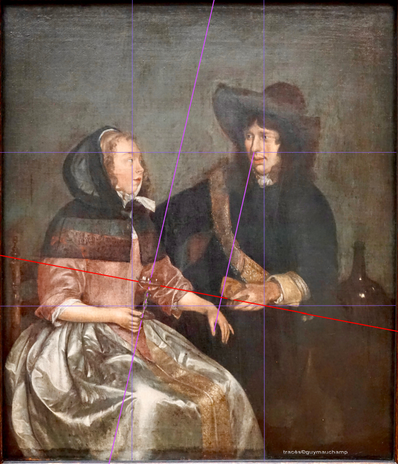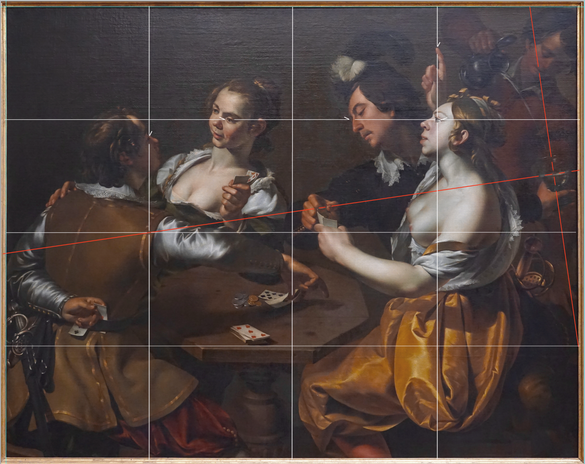
LA COMPOSITION
PICTURALE
ICONOGRAPHIE DE L'IVRESSE
L'usage de la première règle de composition m'a permis de découvrir un jeu iconographique aussi amusant qu'édifiant :
le vin dans les verres est souvent peint incliné, et non horizontal comme le voudrait la loi de gravité.
De nombreux tableaux attestent de la tradition d'une iconographie de l'ivresse avec le vin non horizontal, donc peint avec une inclinaison.
La surface inclinée du vin une fois prolongée en une ligne jusqu'au bord du format révèle souvent une composition voulue par le peintre afin de délivrer un message.
Il existe trois sujets de cette iconographie du vin :
- les scènes sociales
- les scènes amoureuses
- les scènes religieuses.

Gérard Ter BORCH - Jeune couple au vin (détail) - 1663 - Berlin - photo tracés©gm - Le vin blanc est fortement incliné et sa ligne prolongée en rouge pointe l'index de l'homme.

La ligne verte horizontale permet de mesurer l'inclinaison de 10° du vin dans le verre.
Dans cette scène de séduction amoureuse, la femme semble être sensible au charme de l'homme, jusqu'à en perdre peut être son discernement qui lui permettrait de réellement apprécier la situation. Elle tient son verre de vin incliné et selon la loi de gravité, la surface du vin devrait rester horizontale. Or le vin est fortement incliné avec un angle de 10°. Ce subterfuge, voir cette tricherie, agit comme une sorte de métaphore visuelle, un langage créé par les peintres pour parler d'états de conscience modifiés. Ici, par la ligne de la surface du vin qui se prolonge sur l'index de l'homme on comprend que celui-ci aurait des intentions malhonnêtes vis-à-vis de la jeune femme dont le jugement semble être perdu dans l'alcool.
L'ivresse sociale avec Georges de La Tour
C'est en travaillant en 2013 sur l'œuvre très connue du "Tricheur à l'as de carreau" de Georges de La Tour que j'ai débuté mes investigations au sujet de l'ivresse dans les tableaux.
Cette scène de genre inspirée de Caravage illustre les préceptes moraux du XVII° siècle qui incitaient de lutter contre le fléau des jeux d'argent, des excès d'alcool et des plaisirs de la chair avec les courtisanes.
Avec réalisme, de La Tour saisit trois personnages en pleine partie de cartes ainsi que la servante qui les sert en vin.
Je vous propose justement d'observer ce qu'il se passe autour du verre de vin tenu par la servante.
%20gm_JPG.jpg)
Georges de La TOUR - le tricheur à l'as de carreau - 1635 - Louvre - Photo gm
Tout un jeu de mains et de regards se déploie dans cette scène de convoitise, de suspicion et de tricherie. C'est manifestement autour du verre de vin que les mains du tricheur, de la servante et de la courtisane s'activent et se frôlent, comme en prélude au partage de l'or du riche jeune homme. La vue de ce verre de vin en est troublée au point qu'un détail peut échapper à la perception habituelle. En effet, les mouvements de mains et les regards monopolisent l'attention afin d'empêcher de voir une sorte de tricherie moins visible.
Pour voir cette tricherie, il faut détailler le verre de vin et s'aider en traçant les médianes du format.

Tracés du prolongement de la surface du vin en rouge et de l'axe du verre de vin.
QUE SE PASSE-T-IL AUTOUR DU VERRE DE VIN TENU PAR LA SERVANTE ?
En prolongeant l'axe du verre et la surface inclinée du vin, on remarque que le vin n'est pas à l'horizontale mais incliné à 4°. Cette ligne pointe le collier de perles et le jeu de cartes. L'axe vertical du verre, quant à lui, pointe les pièces d'or et le nez de la servante.

Le vin incliné à 4° est parallèle au regard de la courtisane, lui aussi incliné à 4°. Celle-ci regarde la bouche de la servante et le nez du tricheur (en bleu à 9° et 18° selon les angles préférentiels) .
LIEN DU VIN INCLINÉ AVEC LA TECHNIQUE DES REGARDS :
Si on se réfère, ci-dessus, aux deux lignes parallèles, celle du vin et du celle du regard de la courtisane, l'intention de celle-ci semble clairement d'enivrer le tricheur afin d'endormir sa lucidité et s'accaparer le jeune homme riche en usant de ses atouts féminins pour s'octroyer ensuite son argent. Pour montrer cela, de La Tour dirige le regard de la courtisane sur sa servante qui tait le projet de sa maîtresse, ainsi que sur le nez du tricheur qui doit en prendre un coup dans le nez, selon l'expression populaire.
VÉRIFICATION
Par soucis de rigueur scientifique vérifions si ces deux lignes - celle du vin incliné et celle du regard de la courtisane - ne sont pas une illusion à vouloir enfiler la chaussure de Cendrillon à une belle théorie.

Le regard de la courtisane, parallèle au vin, est posé sur la grille harmonique dorée (en jaune) sur le bord du format (flèche rouge à droite)
La flèche rouge ci-dessus, à droite, montre que le regard de la courtisane s'appuie sur la grille harmonique dorée sur le bord du format. Les points de la 1re règle de composition conditionné par cette grille sont les nez des trois protagonistes. Le quatrième nez pointé, celui de la servante, est en relation par l'axe incliné du verre de vin.
La composition de La Tour montre un lien entre le vin qui pointe l'argent et le jeu, soit les trois vices, et trois nez : le nez intuitif de la servante qui comprend l'intention de sa maîtresse (elle a du nez) , le nez du tricheur (en avoir un coup dans le nez) du tricheur, et le nez lié à un symbole de la sexualité pour la courtisane et son futur client.
L'ivresse sociale avec Wouter
Wouter Crabeth II est un peintre néerlandais formé en France et à Rome qui excellait dans les scènes de genre d'inspiration caravagesque. Ses contemporains et lui-même ont été nombreux à utiliser l'iconographie de l'alcool incliné dans les scènes de tavernes.

WOUTER Crabeth II - Les Tricheurs - 1530 - Gemäldegalerie Berlin - photo guymauchamp
Les lignes de la bière inclinée (en rouge) et les grilles harmoniques des médianes et ½ médianes.
La composition montre avec sobriété, si je peux dire, l'usage du vin incliné et de deux grilles harmoniques : le vin (ou la bière ?) est incliné en pointant la bouche du serviteur, l'auriculaire et le pouce de l'homme en noir, le jeu de cartes et les grilles des médianes et demi-médianes. Ces deux grilles harmoniques ont posé les yeux des quatre joueurs et le jeu de carte sur la table. Cette disposition confirme la relation entre l'alcool et la tricherie au jeu de cartes.
L'ivresse Amoureuse avec Vermeer
Dans ce Vermeer ci-dessous, la discrète inclinaison du vin (ligne rouge) rejoint sur le bord du format la grille de composition dorée Phi (en jaune), grille qui a servi de support à la première règle de composition en positionnant, pour les relier, le nez et l'œil de l'homme et la bouche ouverte de la jeune femme.

VERMEER - Jeune Fille au verre de vin (détail) - 1660 -
Le vin incliné dans le verre indique une ligne prolongée (en rouge) qui pointe l'œil de l'homme assoupi et rejoint à gauche sur le bord du format, la grille dorée de composition.
Cette ligne prolongée du vin pointant une grille harmonique est congruente avec le sujet du tableau : une représentation de l'ivresse reliée à la séduction abusive. Ces tracés sont un raccourci saisissant qui illustre l'intention intéressée et sournoise que l'homme porte à la jeune femme par le moyen de l'alcool.
L'ivresse Amoureuse avec Rembrandt

REMBRANDT - Portrait Rembrandt et Saskia - 1635 - Dresden - GoogleArtProject
Dans cette plaisante scène intime, Rembrandt lève son verre comme pour trinquer avec le spectateur, et il est aisé de voir que la surface de la bière est inclinée. La ligne prolongée de cette bière vient se caler sur l'angle de la grille harmonique carré terre. Les lignes de l'âme de Rembrandt (en violet) pointent à 30° (en vert) le même coin du carré terre, à 19° l'âme de sa femme Saskia, et à 45° (orange) et 36° (jaune) les deux pouces.

Rembrandt brandit un verre de bière inclinée (en violet) qui pointe la grille du carré terre sur le format.

Lignes de l'âme de Rembrandt qui pointent sur le format le carré terre et la bière inclinée.
Ces tracés appuient la sensation d'ivresse amoureuse que procure non seulement la bière, mais surtout la tendre relation d'âme à âme que Rembrandt entretient avec son épouse.
L'ivresse spirituelle avec Crivelli
La découverte de cette œuvre a été un grand moment de joie partagée : alors que je visitais en famille la Gemäldegalerie de Berlin, mon fils Colin accourt vers moi en me priant de venir au plus vite voir un tableau dans lequel "il y a du vin incliné !". Mon excitation était à son comble car c'était la première fois que je découvrais une scène religieuse utilisant ce procédé iconographique de "l'alcool incliné"- de plus, avec un tableau monumental de Crivelli réalisé avec un soin extrême.

Carlo CRIVELLI - Marie Jésus et apôtres - 1480 - Gemäldegalerie Berlin - Photo guy mauchamp -
Attirée par notre agitation, une gardienne du musée s'approche, curieuse de voir autant d'enthousiasme. Je lui montre, à l'aide d'une ficelle, que le vin est incliné de façon à pointer plus loin la pierre précieuse sur le front de Jésus, pierre qui est de la même couleur que le vin (ligne tracée en orange ci-dessous). Notre joie est alors partagée avec plaisir par la gardienne, illustrant par le vécu un peu de ce que peut être une ivresse spirituelle !

CRIVELLI - Le vin incliné prolongé en orange pointe la pierre sur le front de Jésus. L'axe du calice pointe l'angle de droite du format du tableau.
Ce vin dans le calice incliné à 4° pointe la pierre sur le front de Jésus ce qui semble suggérer l'idée d'une sorte d'ivresse, voir d'une béatitude spirituelle.
L'axe du calice prolongé verticalement se cale dans l'angle supérieur du format (flèche blanche).
La grille harmonique dorée positionne le couvercle du calice et trois points de la 1re règle : le point de l'âme de Jésus sur son front, un stigmate sur la main de Saint François, et le doigt d'un moine. Cette grille dorée conditionne aussi l'emplacement des personnages et du décor.
Florilège iconographique du vin incliné
N'hésitez pas à laisser votre commentaire, vos questions en pied de page, mon plaisir est de pouvoir échanger avec vous sur la composition picturale. Merci.
Guy MAUCHAMP














